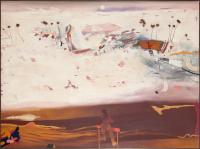Illustrated: "Robert Juniper by Gavin Fry", Published by The Beagle Press 2009, Page 100.
Writing about Robert Juniper can be challenging, as his contribution to
Australian art history is often undervalued on a national scale, despite
his significant influence. After the 1970s, Juniper’s approach to landscape
painting underwent a transformation. Having experienced the landscape from
the viewpoint of a light aircraft, he saw an underlying order that was not
immediately apparent from ground level. This shift in perspective led him
to change his approach to landscape painting by eliminating the horizon
line and covering his canvases in earthy tones. He began to focus on the
features of the landscape and the interplay of light across them, capturing
the essence of the day's atmosphere without relying on the sky.
...
By skilfully varying his tone, Juniper was able to convey the changing
moods of the landscape, whether it was a bright, clear day or a more
subdued, cloudy one. Through his use of light and colour, he allowed
viewers to experience the weather and atmosphere without relying on literal
depictions. This technique provided a fresh perspective on the Australian
landscape.
In “The Rising Moon on Gwalia”, Juniper subtly re-introduces the
horizon, enabling the viewer to understand that the scene is illuminated by
moonlight, rather than being a dull, overcast sky.
In a 1969 interview with Laurie Thomas, Juniper reflected on his sense of
isolation, saying, “There have been periods when I felt I was out of
the mainstream of Australian painting - because of the isolation of Western
Australia. A few years back, it did worry me. But it doesn’t anymore.”Thomas,
on the other hand, believed that Juniper had a poetic sensitivity to the
Australian landscape. Yet, Juniper himself felt his focus was more
localized, not concerned with the broader, national image of Australia. He
explained,
“I feel that I’m developing what I think is an indigenous thing -
indigenous to Western Australia - because I don’t feel any strong
influence from anywhere else.”
Juniper’s work is generally free from external influences, though his
impact on other artists is widely acknowledged. If any artist is said to
have influenced him, it was likely Sam Fullbrook. Upon first encountering
Fullbrook’s North West paintings, Juniper remarked,
“Fullbrook’s paintings then pulsated with the heat of the north and
showed me for the first time a vision beyond the verdant rim, that hot
gut of the Australian landscape.”
While Juniper admired Fullbrook’s use of colour and would later adopt a
similar palette, he never embraced Fullbrook’s glissando technique.
Instead, Juniper was captivated by feel and the quality of paint, which he
used to enhance the surface of his work.
By the time Juniper painted “The Rising Moon on Gwalia”, he had
already gained recognition for his distinctive style and had become
confident in working on a larger scale. He was also beginning to
incorporate elements of both literal and artistic exaggeration into his
landscapes. “The Rising Moon on Gwalia” evokes a powerful sense of
memory, drawing from Juniper’s personal recollections of his visit to the
region, while also inviting curiosity in those who have yet to experience
Gwalia and its surroundings.
The painting captures a quiet, magical moment, immortalizing Juniper’s
memory of the scene: a full moon rises above the ruins of a once-thriving
town, casting subtle shadows across the land. The middle-distance glows
with reflected moonlight, as the effects of the setting sun have faded.
Juniper’s colour palette mirrors the tranquil atmosphere of this hour, while
his gaze lingers on the unfolding scene of a kangaroo scratching and
Juniper’s companion wandering through the ruins.“
The Rising Moon on Gwalia”
stands as a major piece in Juniper’s oeuvre.
Read more


